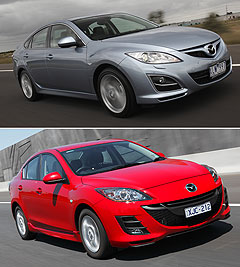Upcoming hybrid ‘true Mazda’
BY BYRON MATHIOUDAKIS | 12th Apr 2010

This means the Prius 1.8-litre Atkinson cycle four-cylinder petrol engine and CVT transmission will not be part of the deal to Mazda, which will first bear fruit in a hybrid model in Japan from 2013.
Instead, the company will employ its new-generation Sky direct-injection internal combustion engine technology and Sky Drive six-speed automatic gearbox – a transmission that Mazda claims has almost double-clutch-like response and efficiency.
Announced at last year’s Tokyo motor show in both ‘G’ petrol and ‘D’ diesel applications, the Sky drivetrains will debut in 2012 in either the next-generation Mazda2, CX-7 or Mazda6 models due in Australia from 2013, and will replace all existing internal combustion engines thereafter – although Mazda is keeping mum on whether this also includes the rotary engine.
The Toyota hybrid system will most likely be applied to an existing mainstream model such as a Mazda3 or Mazda6, rather than in a dedicated stand-alone series offshoot such as what Toyota and Honda have done with their respective Prius and Insight.

Whether Australian buyers will get a chance to sample the Mazda hybrid has yet to be determined.
“The hybrid we are buying is an add-on electric device – that’s all it is,” said Mazda Australia marketing manager Alastair Doak.
“We are not buying anything more than that from Toyota. We control how the car drives, how it brakes, how it steers and how it feels like to the customer.
“And what we have consistently said – and that is that Mazda’s are fun to drive – doesn’t change, so whether it is a diesel, a petrol, a hybrid, a hydrogen hybrid, it doesn’t matter.
“When the customer drives our cars they will feel exactly the same thing. Nothing will change. And that is what our point of difference is and that’s where our brand is.” Since affordability and reliability are also key drivers in the new Mazda Hybrid, Mazda has also confirmed that the Prius’ current, old-fashioned Nickel-Metal Hydride (NiMH) battery pack will be bought from Toyota, instead of the upcoming lithium-ion (li-ion) Panasonic battery type (as used in everyday electronics like mobile phones and laptop computers) to be offered on the Prius plug-in hybrid vehicle versions from the end of next year.
While Mazda agrees that li-ion batteries are lighter, smaller and much more efficient they are also significantly more expensive to produce, and pricing its future hybrid out of the reach of many mainstream consumers defeats the purpose of buying the technology from Toyota in the first place.
“It’s good to project an image of being at the forefront of environmental friendliness, but what we need to do is provide a real benefit to customers when we introduce new environmental technology,” said Mazda’s global chief for marketing, sales and customer service, Masazumi Wakayama.
Speaking to the Australian media in Melbourne earlier this month, the 40-year Mazda veteran said the company’s goal was to be competitive with an attainable hybrid that more people could afford.
“But we have to consider how many customers will be able to utilise (new technologies like expensive and range-limiting electric vehicles) in everyday life,” he said.
Mr Doak added: “We have known technology that we are adopting in the short term, and then we will be building upon that.” Mazda announced its plans to buy Toyota’s hybrid system in late March after years of ignoring the burgeoning hybrid market around the world, to help it meet a commitment of increasing the average fuel economy of Mazda vehicles sold globally by 30 per cent between 2008 and 2015.
To be included in consumer dialogue about hybrids is another important factor behind Mazda’s decision.
“Society is moving away from fossil fuels so we need to be prepared to also move away from fossil fuels,” Mr Wakayama said.
“In Japan the hybrid sales ratio is quite high already, more than 10 per cent and maybe even as close as 20 per cent.
“And (though they are coming) electric vehicles will probably only account for 10 to 15 per cent of sales in 2020 depending on what sort of incentives governments give … and so the important thing for us is to maximise the internal combustion engine’s efficiencies.
“After that, we can introduce new technologies step by step, for example idle-stop technology and regenerative braking in our hybrid system – we call it our ‘Building Block’ strategy.”